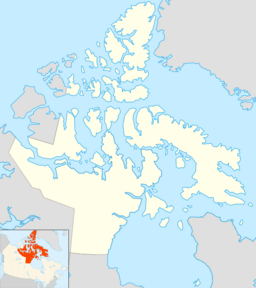Ungava Bay facts for kids
Quick facts for kids Ungava Bay |
|
|---|---|

Aerial view of north-eastern Ungava Bay close to Cape Chidley, seen from north-west towards south-east. In the foreground is drift-ice, in mid-July.
|
|
 |
|
| Location | Hudson Strait |
| Coordinates | 59°30′N 67°15′W / 59.500°N 67.250°W |
| Basin countries | Canada |
| Max. length | 320 km (200 mi) |
| Max. width | 260 km (160 mi) |
| Surface area | c. 50,000 km2 (19,000 sq mi) |
Ungava Bay (French: baie d'Ungava, Inuktitut (syllabics/Roman) ᐅᖓᕙ ᑲᖏᖅᓗᒃ/ungava kangiqluk) is a bay in northeastern Canada separating Nunavik (far northern Quebec) from Baffin Island. Although not geographically apparent, it is considered to be a marginal sea of the Arctic Ocean for climatic reasons. The bay is roughly oval-shaped, about 260 km (160 mi) at its widest point and about 320 km (200 mi) in length; it has an area of approximately 50,000 km2 (19,000 sq mi). It is generally fairly shallow, under 150 m (490 ft), though at its border with the Atlantic Ocean depths of almost 300 m (980 ft) are reached.
Geography
Although it is quite close to the open Atlantic (separated only by Hudson Strait), Ungava Bay is part of the Arctic Ocean. Ungava Bay is separated from Hudson Bay by the Ungava Peninsula. Akpatok Island is largest of the many islands in Ungava Bay. Bathymetric studies suggest that Ungava Bay may be the remnant of an impact crater (age unknown) approximately 225 km (140 mi) in diameter.
The southwestern corner of Ungava Bay vies with the Bay of Fundy for the highest tidal range in the world. Some sources estimate the spring tide range at the mouth of the Leaf River as being as high as 17 m (56 ft). Attempts have been made to develop tidal power in the bay, but this is made difficult by the harsh climate and the fact that the bay is ice-free for only a small part of the year.
Climate
Due to the influence of the Labrador Current, summers are too cold for tree growth and all the land surrounding the bay is treeless tundra. Typically, temperatures in summer at Kuujjuaq about twenty kilometres up the Koksoak River are about 7 °C (45 °F), while winter temperatures are about −20 °C (−4 °F). Precipitation averages around 400–450 mm (16–18 in) per year, most of it falling in the summer.
See also
 In Spanish: Bahía de Ungava para niños
In Spanish: Bahía de Ungava para niños


